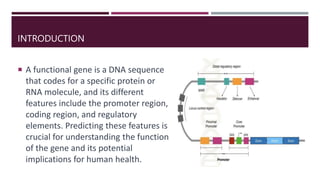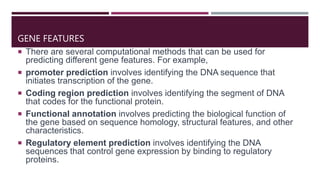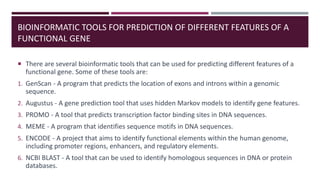Prediction of different features of a functional gene.pptx
- 1. Prediction of different features of a functional gene Okechukwu Francis Programme: PhD Biotechnology SCHOOL OF HEALTH SCIENCE AND TECHNOLOGY (SoHST)
- 2. INTRODUCTION ï‚¡ A functional gene is a DNA sequence that codes for a specific protein or RNA molecule, and its different features include the promoter region, coding region, and regulatory elements. Predicting these features is crucial for understanding the function of the gene and its potential implications for human health.
- 3. GENE FEATURES ï‚¡ There are several computational methods that can be used for predicting different gene features. For example, ï‚¡ promoter prediction involves identifying the DNA sequence that initiates transcription of the gene. ï‚¡ Coding region prediction involves identifying the segment of DNA that codes for the functional protein. ï‚¡ Functional annotation involves predicting the biological function of the gene based on sequence homology, structural features, and other characteristics. ï‚¡ Regulatory element prediction involves identifying the DNA sequences that control gene expression by binding to regulatory proteins.
- 4. BIOINFORMATIC TOOLS FOR PREDICTION OF DIFFERENT FEATURES OF A FUNCTIONAL GENE ï‚¡ There are several bioinformatic tools that can be used for predicting different features of a functional gene. Some of these tools are: 1. GenScan - A program that predicts the location of exons and introns within a genomic sequence. 2. Augustus - A gene prediction tool that uses hidden Markov models to identify gene features. 3. PROMO - A tool that predicts transcription factor binding sites in DNA sequences. 4. MEME - A program that identifies sequence motifs in DNA sequences. 5. ENCODE - A project that aims to identify functional elements within the human genome, including promoter regions, enhancers, and regulatory elements. 6. NCBI BLAST - A tool that can be used to identify homologous sequences in DNA or protein databases.
- 5. APPLICATIONS ï‚¡ The accurate prediction of different gene features has several applications in genetics research, including gene therapy, ï‚¡ drug development, and disease diagnosis. For example, gene prediction has been used to identify new drug targets for certain diseases or to diagnose genetic disorders.
- 6. EXAMPLES OF HOW GENE PREDICTION HAS BEEN USED TO IDENTIFY NEW DRUG TARGETS OR TO DIAGNOSE GENETIC DISORDERS ï‚¡ Cystic fibrosis is a genetic disorder caused by mutations in the CFTR gene, which encodes a protein involved in chloride ion transport. ï‚¡ Gene prediction has been used to identify the location of the CFTR gene and to develop drugs that target its function. One example is the drug Ivacaftor, which has been approved for the treatment of cystic fibrosis in patients with specific mutations in the CFTR gene.
- 7. ï‚¡THANK YOU







